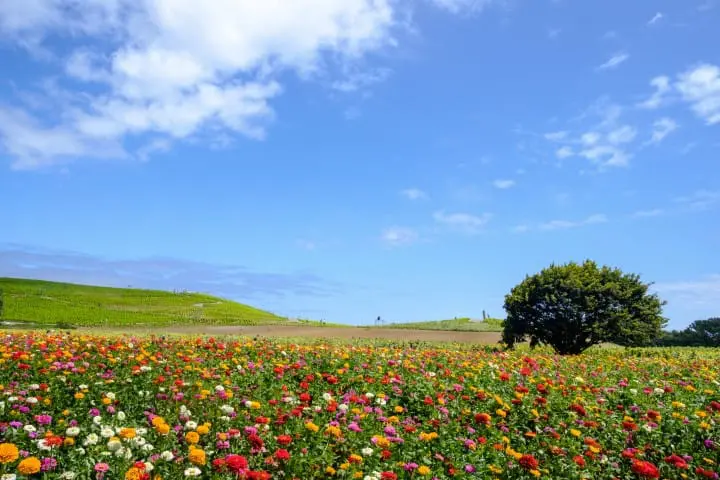Hitachi Seaside Park - Gaze Upon Nemophila, Cosmos, And Zinnia Flowers!

Hitachi Seaside Park is one of the top scenic sites in eastern Japan. Aside from the popular nemophila flowers in early summer and kochia in autumn, stunning flowers can be seen year-round. We introduce access information, along with tips on the best viewing times.
Hitachi Seaside Park - A Flower Paradise in Ibaraki

Pleasure Garden Area. Picture courtesy of Pixta
Hitachi Seaside Park, a Japanese national park, is one of the top sightseeing gems in Ibaraki, north of Tokyo. The vast park stretches over roughly 200 hectares and is divided into seven areas.
The West Entrance Area is where narcissuses and tulips bloom in spring, whereas in the Forested Area, you can bathe in the freshness of Japanese red and black pines. Take some time to head to the Sawada spring pond, a scenic attraction also located in this area.
Nemophila (baby blue eyes) and kochia (summer cypress) flowers blossom across the Miharashi Area in the springtime, while in autumn, you can look forward to the stunning sight of flourishing cosmos in the Grassland Area.
Furthermore, the Dune Garden is where you can enjoy pottery making and gardening while feeling the pleasant sea breeze. On the other hand, the South Entrance Area is where visitors can admire the soaring metasequoias and enjoy the autumnal leaves while strolling through the broad-wood forest. Lastly, there is also an amusement park for children in the Pleasure Garden Area.
Aside from enjoying the seasonal flowers, the barbecue plaza, athletic field, and cycling course are ideal for those wishing to partake in an array of outdoor activities.
Seasonal Flowers of Hitachi Seaside Park: When and Where to Find Them
Spring: Tulips

Picture courtesy of Pixta
From mid to late April, the tulips of Tamago no Mori Flower Garden steal the spotlight in the West Entrance Area. An annual event called Tulip World is held around this time and more than 250,000 tulips from over 250 different varieties—alongside egg-shaped objects and windmills—brightly color the forest landscape.
The charming atmosphere will make you feel as though you've entered a picture book and the colorful tulips will certainly cheer up spectators.
Early Summer: Nemophilas

Picture courtesy of Pixta
Starting in late April to mid-May is the nemophila (a.k.a. baby blue eyes) season on Miharashi Hill: the highest elevation in Hitachinaka City, located in the park's Miharashi Area.
The hill is covered in a spectacular sea of more than 4,500,000 nemophila flowers. A blue trio—composed of the sky, sea, and 4,500,000 nemophilas—forms an unparalleled, jaw-dropping scenery that you cannot see anywhere else.
In recent years, the beautiful sights in this park have become a trend around the globe and many visitors gather here during Golden Week to get a first glimpse of the nemophila fields.
Summer: Zinnias

Picture courtesy of Pixta
From early August to the beginning of September, you can admire the zinnia flowers in full bloom at the foot of Miharashi Hill in Miharashi no Sato. In Japanese, zinnia literally means “one-hundred-day flower." Just as the name suggests, many little buds begin to consecutively appear on its stem, creating a lovely sight over a long period of time.
More than 350,000 zinnias of eight different varieties make a stunning, multi-hued sight to behold. Alongside the sunflowers and kochia (summer cypresses) growing nearby, there is a time of the year when this trio of flowers can be viewed all at once.
Autumn: Kochia

Picture courtesy of Pixta
The kochia on Miharashi Hill is as popular an attraction as the nemophilas. The kochia begin to flourish in early July and is characterized by its cute shape that is soft to the touch. The color begins to gradually change from late September to early October, and by the time autumn arrives, Miharashi Hill will be overflowing with flaming-red foliage.

photo by Pixta
The kochia's slow transition from green to red looks like a work of art. As the season begins to settle deeper into autumn, the scenery shifts to a radiant maroon color, enveloping the area with a charming atmosphere.
Autumn: Cosmos Flowers

Picture courtesy of Pixta
From early to mid-October, the cosmos are at their peak bloom. The foot of Miharashi Hill begins to turn red, white, and pink from the tricolored cosmos in full bloom—signaling that autumn has truly come. This spectacular sight at the foothill is complemented by the brightly red kochia flowers at the top, which isn’t something you can see just anywhere.
In addition, you can also stroll around the Grassland Flower Garden, located inside the Grassland Area, where you can appreciate various colorful cosmos, such as the orange and golden yellow sulfur cosmos.
Facility Guide of Hitachi Seaside Park

Picture courtesy of Pixta
The entrance fee for adults (high school students and over) is 450 yen and senior citizens (age 65 and over) is 210 yen. Junior high school students and younger enter for free.
The business hours also vary depending on the season.
March 1-July 20: 9:30-17:00
July 21-August 31: 9:30-18:00
September 1-October 31: 9:30-17:00
November 1-end of February: 9:30-16:30
The park is closed on Mondays (if a holiday falls on Monday, the park will be closed on the following Tuesday), as well as on December 31, January 1, and on the first Tuesday in February until Friday that same week.
*The park is open every day on the following dates: March 26-May 31; July 21-August 31; October 1-October 31; December 25-30; January 2-7.
How to Reach Hitachi Seaside Park

Katsuta Station. Picture courtesy of Pixta
By Train from Tokyo Station
The nearest station to Hitachi Seaside Park is JR Katsuta Station along the Joban Line.
If you depart from Tokyo Station, it’ll take seven stations by limited express Hitachi or Tokiwa (bound for Katsuta) aboard the JR Joban Line. It takes approximately 90 minutes and the limited express train one-way ticket (with the reserved seat fee included) is 3,820 yen.
Another option is to take a transit bus from Katsuta Station to the park. From Katsuta Station's East Exit Bus Stop No. 2, it takes about 15 minutes to reach the park’s West Entrance. The South Entrance can be reached in roughly 20 minutes. The one-way ticket costs 400 yen for junior high school students and over; 200 yen for elementary school students and younger.
By Intercity Bus from Tokyo Station
If you’re arriving via the intercity bus from Tokyo Station, take the Ibaraki Kotsu Katsuta/Tokai Line bus from Tokyo Station Yaesu South Exit, and get off at Seaside Park's West Entrance bus stop. It takes about two hours one-way and a roundtrip ticket costs 4,480 yen.
Have Fun in Hitachi Seaside Park!
Hitachi Seaside Park is where seasonal flowers can be enjoyed by visitors all year round. The budget-friendly admission fee of only 450 yen per adult also adds to the park's charm.
Don’t forget to prepare your camera or smartphone beforehand, especially if you’re visiting during the blossoming seasons! You'll likely be able to capture the park’s beautiful glory in that one special photo.
Hotels near Hitachi Seaside Park
湘南生まれのフリーライター・編集者。海外の音楽フェスに行くことがライフワークです。 freelance writer and editor from Shonan.i love world music festival.











































![[Coupon Available] Attention Overseas Winter Sports Fans! Nagano's Sports Depot Has Evolved](https://resources.matcha-jp.com/resize/720x2000/2026/01/05-254819.webp)
![[2 hours from Tokyo ] 10 Quiet and Breathtaking Views of Mount Fuji in Yamanashi Hokuto City , Yamanashi - Part 2](https://resources.matcha-jp.com/resize/720x2000/2025/12/16-253037.webp)
